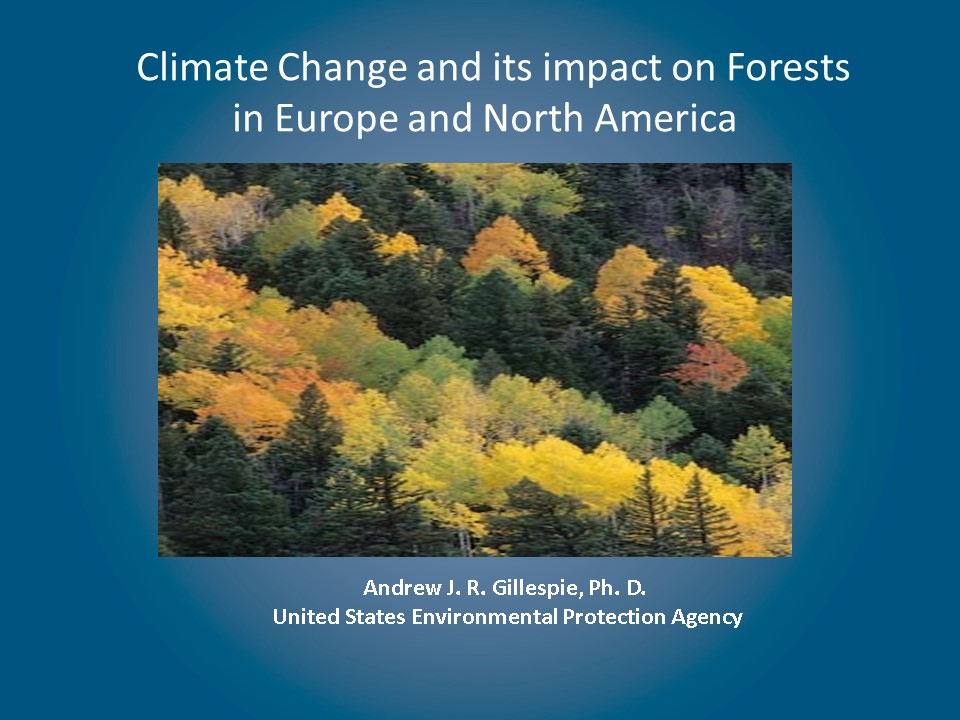Climate Change and its impact on Forests - PowerPoint PPT Presentation
Title:
Climate Change and its impact on Forests
Description:
Climate Change and its impact on Forests in Europe and North America Andrew J. R. Gillespie, Ph. D. United States Environmental Protection Agency – PowerPoint PPT presentation
Number of Views:820
Avg rating:3.0/5.0
Title: Climate Change and its impact on Forests
1
Climate Change and its impact on Forests in
Europe and North America
Andrew J. R. Gillespie, Ph. D. United States
Environmental Protection Agency
2
Goal of Presentation
- Overview of climate science relevant to forests
- Implications for forests in Europe and North
America - What we are doing about it
3
- Climate long term (30 year) trends in
atmospheric behaviors such as temperature,
rainfall, humidity, wind patterns, and storms. - Weather short term (days) atmospheric behavior
- Climates are always changing dynamic systems,
not constant - Difference today is the rate at which climate is
changing - Evidence that it is more rapid than usual for
last 800,000 years - Evidence that it is due to fossil fuels and
deforestation
4
How do we know climate is changing?
- Direct measurements since the mid 1800s
- Daily temperature, precipitation/many locations
- Glacier shrinkage
- Multiple other lines of research prior to 1800s
- Ice cores
- Tree rings
- Pollen analysis
- Geologic evidence of ice ages, warm periods
5
(No Transcript)
6
Climate Change Impacts in the United States The
Third National Climate Assessment
7
(No Transcript)
8
(No Transcript)
9
(No Transcript)
10
Likely Aspects of Climate Change
- Increase in heat retained in ocean and atmosphere
- Slight increase (2-4 degrees) in average global
temperature by the end of the century - More change at the poles
- Hotter summers, milder winters
- Warmer oceans
- More energy more extreme weather
- Hurricanes, blizzards, heat waves, wind storms
- Change in rain patterns
- More precipitation but uneven distribution
- More droughts, floods
- Rising sea levels as ice melts
11
Relationship between Climate and Forests
Ecological Niche Set of environmental conditions
which enable a species to survive and thrive.
Combination of multiple factors Climate
temperature, precipitation, storm
events Physical soil characteristics,
elevation, aspect Analogous to concept of
terroir for wine making Change in climate gt
change in niche Animals can migrate to follow
niches Trees move much more slowly
12
Relationship between Climate and Forests
Change in climate gt change in niche Change in
niche gt existing forests come under
stress Increase in stress gt vulnerability to
other threats disease, insects, fire, loss of
biodiversity Loss of forest gt more CO2 in
atmosphere gt more climate change
13
Likely changes in forest ecosystems
- Warmer average temperatures
- Longer growing season
- CO2 fertilization effect
- Increased precipitation, changes in rainfall
patterns - More extreme weather (ice storm, wind storm,
drought, flood) - Changes in soil moisture wetter and drier
seasons - Increased insect/disease presence due to less
winter die-off - Net result is general increase in ecosystem
stress, resulting in increased forest
vulnerability to other threats
14
Likely forest ecosystem response
- Northward migration of some tree species
- Changes in forest species composition,
succession - Increased tree mortality, fire risk
- Increased spread of invasive species
- Loss of biodiversity, genetic resources,
ecosystem - services
15
Climate and Forests North America
Canada 397 million ha US 327 million
ha Mexico 50 million ha TOTAL 774
million ha ( 80 x area of Hungary) North
America forest extends from subtropical to
boreal Many different forest types, ecological
conditions
16
(No Transcript)
17
Relationship between Climate and Forests
- Successful forest fire prevention gt overstocked
forests - Overstocking causes stress
- Climate-related drought adds to stress
- Insects able to infest stressed forests
- Result is greatly increased tree mortality,
higher fire risk - Illustrates need for systems thinking,
sustainability perspective
18
(No Transcript)
19
Impacts of Climate Change on European Forests
and Options for Adaptation
European Forest Institute et al.
20
Climate Change and Ecosystem Response Temperate
Continental Region
- Changes in rainfall distribution
- Wetter winters flooding, wind damage, ice
storms - Dryer, longer summers more drought stress
- Warmer temperatures gt increased pest problems
- Bark beetles, gypsy moth, Phytophthora
- Increase insect, disease populations due to less
winter die-off - Increased northern ranges
21
Climate Change and Forest Response Hungary
22
Climate Change and Forest Response Hungary
- Example European beech in Hungary (C. Mátyás et
al.) - Beech at southern limit of range in Hungary
- Xeric limit genetically determined dryness
tolerance - Northward shift in xeric limit could lead to
complete loss - of beech, replacement with oak
- Permanent loss of genetic diversity
23
Climate Change and Forest Response Hungary
24
Strategies for Managing Forests in a Changing
Climate
- Mitigation reduce C emissions, increase C
sequestration by growing forests - Adaptation manage forests to maintain health,
reduce vulnerability - Transformation change society expectations,
behaviors regarding what people want, need from
forests and what we are willing to give back
25
Scale Matters
- Adaptive strategies are synergistic across large
areas - More ecological niches to work with
- More resources (financial, intellectual) to
work with - Argues for benefit to international cooperation
- Certainly at continental scale
- Also at global scale
26
Need for Action
Continue research to provide good
foundation Need to move beyond research to
action Adaptive management, systems
thinking Plan Act Measure Analyze
and repeat
27
Winter Summer
is coming
28
Thank you for your Attention
Andrew Gillespie Gillespie.andrew_at_epa.gov Twitt
er _at_ajrgillespie1

